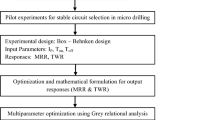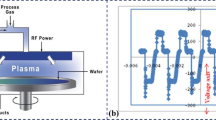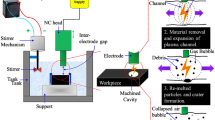Abstract
Cobalt-base alloys are generally adopted in applications that require wear, corrosion, and heat resistance. In particular, cobalt–chromium–molybdenum (Co–Cr–Mo) alloy is currently being used in the aerospace and medical field. Both applications require product personalization and take advantage by parts manufacturing through additive technologies, such as direct metal laser sintering (DMLS). This technology still has limitations for the manufacture of small cavities, such as holes with diameters below 0.6 mm and high aspect ratio, which require drilling of the additive manufactured part. This research aims at investigating the effects of electrodischarge drilling (EDD) on surface and subsurface features of CoCrMo samples built by DMLS. High aspect ratio holes are produced with diameter of 0.6 mm and depth 15 times higher. Due to the absence of physical contact between tool and workpiece in EDD, machining forces are negligible and microfeatures can be produced with a high accuracy irrespective of the material hardness and strength. In this study, peak current, pulse-on-time, and duty ratio are adopted as control factors using the Taguchi method. Material removal rate, Electrode wear rate (EWrate), and surface roughness are measured as responses. S/N ratios and analysis of variance analysis lead to identify the significant process parameters and the optimal combination level of machining parameters. From the responses can be determined which ensures high productivity and smooth surface finish, even if tool wear is medium high. All the analyses are supported by the study of material removal mechanisms and surface morphology in the microscale, to account for the macroscopic trends.
Similar content being viewed by others
References
Agarwal SC, Ocken H (1990) The microstructure and galling wear of a laser-melted cobalt-base hardfacing alloy. Wear 140:223–233
Crook P (1990) Cobalt and cobalt alloys. In: Properties and selection: nonferrous alloys and special-purpose materials. ASM handbook, vol. 2, ASM International, USA, pp 1404–1424
Bhat SV (2005) Biomaterials. Alpha Science International, UK
Walter MJ (2006) Benefits of P/M processed cobalt-based alloy for orthopaedic medical implants. Carpenter Technology Corp., Wyomissing. http://www.cartech.com/techarticles.aspx?id=1468. Accessed Apr 2011
Eyers D, Dotchev K (2010) Technology review for mass customization using rapid manufacturing. Assem Autom 30:39–46
Aykut S, Bagci E, Kentli A, Yazicioglu O (2007) Experimental observation of tool wear, cutting forces and chip morphology in face milling of cobalt based super-alloy with physical vapour deposition coated and uncoated tool. Mater Des 28:1880–1888
Kumar S (2008) SLS of iron-based powders and SLS/SLM for rapid tooling. Ph.D. dissertation, Katholieke Universiteit Leuven, BE
Emmelmann C, Petersen M, Goeke A (2009) Laser freeform fabrication for aircraft applications. Proceedings of the fifth international WLT-conference on lasers in manufacturing, June 15–18, Munich (DE), pp 171–174
Vandenbroucke B, Kruth JP (2007) Selective laser melting of biocompatible metals for rapid manufacturing of medical parts. Rapid Prototyp J 13:196–203
Bassoli E, Gatto A, Iuliano L (2005) New developments in steel formulations for direct laser sintering: characterization and evaluation of joining mechanisms. Virtual modelling and rapid manufacturing, advanced research in virtual and rapid prototyping. Taylor & Francis, The Netherlands
Arcam EBM ASTM F75 Co–Cr–Mo. www.arcam.com/…arcam…/Arcam-ASTM-F75-Cobalt-Chrome.pdf. Accessed Apr 2011
Del Corso GJ (1995) Co–Cr–Mo, powder metallurgy articles and process for their manufacture. Patent: 5462575
Phadke MS (1989) Quality engineering using robust design. Prentice Hall, Englewood Cliffs
Park H (1996) Robust design and analysis for quality engineering, 1st edn. Chapman Hall, London
Govindan P, Joshi SS (2010) Experimental characterization of material removal in dry electrical discharge drilling. Int J Mach Tools & Manuf 50:431–443
Jahan MP, Wong YS, Rahman M (2010) A comparative experimental investigation of deep-hole micro-EDM drilling capability for cemented carbide (WC-Co) against austenitic stainless steel (SUS 304). Int J Adv Manuf Technol 46:1145–1160
Kung KY, Horng JT, Chiang KT (2009) Material removal rate and electrode wear ratio study on the powder mixed electrical discharge machining of cobalt-bonded tungsten carbide. Int J Adv Manuf Technol 40:95–104
Author information
Authors and Affiliations
Corresponding author
Rights and permissions
About this article
Cite this article
Gatto, A., Iuliano, L., Calignano, F. et al. Electrodischarge drilling performance on parts produced by DMLS. Int J Adv Manuf Technol 58, 1003–1018 (2012). https://doi.org/10.1007/s00170-011-3446-8
Received:
Accepted:
Published:
Issue Date:
DOI: https://doi.org/10.1007/s00170-011-3446-8




